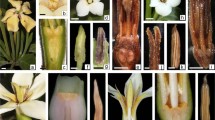Abstract.
Female floral structure is compared in Geonomeae (Arecaceae). A perianth is formed by two alternate whorls of three basally congenitally united and imbricate sepals and three basally congenitally united and apically valvate petals. A sterile androecium is formed by a variable number of staminodes, which are united into a tube. The gynoecium shows three more or less equally developed carpels or is pseudomonomerous (Geonoma). The single anatropous ovule per carpel is median, either basal or at mid-height of the ovary. A septal nectary is present at the base and mid-height of the ovaries and exits at different levels of the ovary. Carpels in pseudomonomerous gynoecia seem to be “basistylous”, but the styles are more lateral or apical in gynoecia with all three carpels equally developed. Stigmas expose unicellular or multicellular (Welfia) papillae at anthesis. Pollen tube transmitting tracts and a compitum are present in the ventral slits of the postgenitally united styles. Floral structure in Geonomeae is compared with other Arecaceae, especially Arecoideae, in a morphological and systematic context.
Similar content being viewed by others
Author information
Authors and Affiliations
Corresponding author
Rights and permissions
About this article
Cite this article
Stauffer, F., Endress, P. Comparative morphology of female flowers and systematics in Geonomeae (Arecaceae). Plant Syst. Evol. 242, 171–203 (2003). https://doi.org/10.1007/s00606-003-0030-1
Received:
Published:
Issue Date:
DOI: https://doi.org/10.1007/s00606-003-0030-1




